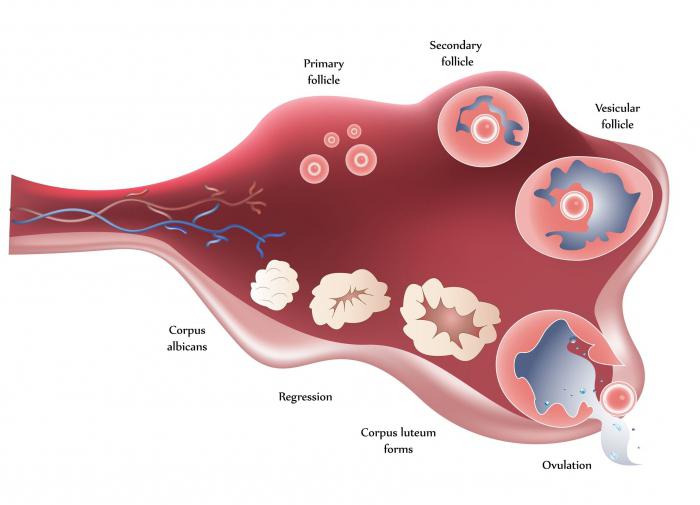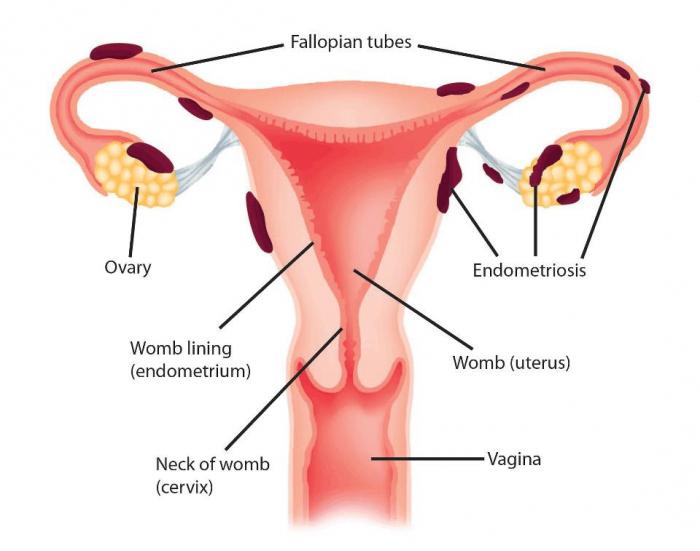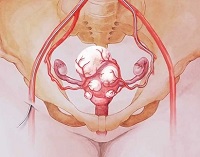Vaginal discharge should normally be constantly present and consist of mucus, which is produced by the glands of the reproductive system. They are not abundant and help cleanse the genital tract and prevent the penetration and development of pathogens. If everything is normal, then the discharge is mucous, transparent or slightly cloudy, of varying consistency and abundance depending on the phase of the cycle.
Bloody issues are characteristic of the menstrual period, but sometimes they appear at a completely inappropriate time for them - in the middle of the cycle, which causes considerable concern in the woman. We suggest you consider all possible reasons and find out what it means and whether you should worry about your health.
Possible diseases
Intermenstrual discharge in the middle of the cycle of a bloody nature may well be a “bell” notifying about the presence and development of a health problem. If we consider such a manifestation as a symptom, then it may be present in the symptom complex of the following ailments and disorders:

- inflammation of the uterus (endometritis), which is also accompanied by the appearance painful sensations and increased body temperature. Often becomes a direct consequence of an abortion;
- endometriosis or excessive growth of the endometrium lining the inside of the uterus;
- infectious lesions of the internal genital organs, especially when they become chronic;
- polyps or fibroids of the uterus;
- early miscarriage;
- irregular appearance of blood in the middle of the cycle may well indicate the development of uterine fibroids;
- decreased activity of the thyroid gland and the resulting hormonal imbalance;
- Brown discharge may indicate progesterone deficiency or polycystic ovary syndrome. These conditions require mandatory treatment, otherwise they can lead to infertility of the woman;
- a consequence of various gynecological procedures of a therapeutic or diagnostic nature (for example, cauterization or biopsy);
- cancer affecting the cervix.
Discharge of blood from the vagina in combination with sudden and severe pain in the lower abdomen may be evidence of ovarian rupture and require immediate medical attention.
For all the problems described great importance has a timely diagnosis of the cause, which will allow prescribing effective treatment. Many of the diseases are dangerous not only for a woman’s reproductive function, but also for her life, so at the slightest suspicion of a problem, contacting a doctor should be done immediately.
In what cases is this normal?
Bloody discharge in the middle of the cycle may be a variant of the norm, and the first possible reason for this state of affairs is ovulation. The egg matures during the first half of the cycle, and in the absence of any deviations, exactly in the middle of it, it exits into the fallopian tube, moving towards the uterus, and being completely ready for fertilization. During this period it is produced big number female hormones, which may well cause a certain amount of discharge. They are usually slimy in nature with a reddish tint, or may be a dull brownish-red color. The appearance of barely noticeable bleeding is considered normal in women taking hormonal contraceptive drugs. However, if such a “daub” has been observed for several months, then it is worth contacting a specialist - perhaps there is a need to switch to another drug.

Among other things, there is a possibility of slight damage to the vaginal mucosa during active sexual intercourse - the discharge will then be extremely scanty and will most likely be detected as no more than a few spots of blood on the underwear. In a single episode, the situation does not require medical intervention and is not a problem. If discharge appears in a woman over 40 years old, then it is likely a signal of the onset of menopause. In this case, they will be quite abundant and as similar as possible to menstruation.
Causes of blood clots
Blood clots are a situation that should definitely be discussed with a gynecologist, especially if the situation recurs more than once. The causes of such discharge can be some pathological conditions, for example:
- peeling of the epidermis with endometriosis occurs too actively, given the intensity of the growth of the uterine mucosa. Thus, it is the appearance of clots that sometimes becomes the symptom because of which a woman goes to the doctor and learns about the diagnosis;
- There may be a bend of the cervix. In this case, regardless of the root cause of the bleeding, the blood cannot come out normally, lingering at the point of inflection. Temporary stagnation leads to its coagulation, and then the masses come out in the form of clots. In such a situation, it is important that they come out and do not linger in the uterus, because otherwise it can become a focus of the inflammatory process;
- the symptom may be a manifestation of the disease during menopause. Signs of a problem during such a period may include the following symptoms: heavy bleeding, discharge of blood masses after sexual intercourse, severe disruptions in the dates of menstruation.
Early pregnancy

There is such a thing as implantation bleeding. Its essence is that the fertilized egg must attach to the wall of the uterus, penetrating into its mucous layer. Considering how well developed the vascular network is in this organ, there is a possibility that during such implantation the integrity of one of the vessels will be compromised, which will lead to bleeding. Taking into account the peculiarities of female physiology, implantation bleeding occurs without pain, about a week before the next period, but it does not occur so often. Thus, mucous discharge with bloody impurities may well be considered as.
Natural physiological process
7-10 days before the onset of menstruation, spotting, which was already mentioned earlier, may occur due to ovulation or the implantation of a fertilized egg into the endometrium of the uterus - and this is a variant of the norm. It is also worth noting that within a few days, even within hours of the onset of menstruation, slight brown spotting may appear - this also should not cause you to worry.
After menstruation, drops of blood may appear for several days, for which a daily sanitary pad will be enough - this is a natural process, thus the uterus gets rid of the blood that could remain after menstruation. However, discharge before or immediately after menstruation may also be evidence of a problem. So, if a brown “daub” occurs almost at the very beginning of the cycle, then this is most likely a symptom of uterine endometriosis. Regular brown discharge before the start of your next period may indicate a hormonal imbalance, the presence of an inflammatory process or polyps in the uterus.
Other diseases already mentioned above remain relevant:
- myoma;
- infectious lesions;
- genital injuries;
- cervical cancer, etc.
Uterine bleeding may occur at any time during the cycle. It is necessary to be able to recognize such a process in order to contact doctors in a timely manner, otherwise the situation may become dangerous character. The main features of uterine bleeding are:
- filling the pad in an hour;
- duration of the phenomenon;
- the presence of dark lumps in the discharge;
- recurring sharp pains in the genital area;
- signs of anemia;
- drowsiness, general weakness of the body.
Video consultation with a gynecologist
This video is an answer from a gynecologist to a question about the possible and most common causes of intermenstrual bleeding. When should you see a doctor? Why do my periods come with clots and what situation is normal? You will find answers to these questions in this short and informative video.
Almost half of women throughout their lives have encountered such an unpleasant phenomenon as bleeding in the middle. menstrual cycle. The reasons for its occurrence are very diverse. An important role in establishing a diagnosis is played by the woman’s age, whether she has children, regularity of sexual activity, and intake of various medicines, stability of the menstrual cycle, course of chronic diseases. The combination of these factors is usually determined by the gynecologist before examining the patient.
Is vaginal bleeding really that bad?
In most cases, the opening of slight bleeding, the duration of which does not exceed three days, is not considered a pathology and is not an indicator of the presence of any serious disease of the genitourinary system. Frequent, long-lasting bleeding in the middle of the cycle may indicate diseases of the uterus.
Most often, unexpected vaginal bleeding occurs 12-15 days after the start of the last menstruation, precisely during the period when ovulation occurs. This is due to fluctuations in the level of estrogen in a woman’s body; as a result of such fluctuations, the lining of the uterus (endometrium) weakens, causing a slight release of blood. If such a phenomenon worries a woman very much, she is prescribed special dietary supplements that regulate the level of estrogen in the blood.
Causes of bleeding in the middle of the cycle
Possible causes of bleeding in the middle of the cycle may be:
- Hormonal changes in the body that precede ovulation;
- Miscarriage (sometimes this happens during early stages pregnancy, when the woman is not yet aware of its presence);
- Using a fallopian device as a means of preventing unwanted pregnancy;
- Taking birth control pills;
- Thyroid gland dysfunction;
- Medical intervention in the area of the reproductive system (termination of pregnancy, cauterization of erosion);
- Severe nervous tension, frequent stress;
- Receiving trauma to the vagina (for example, due to rough sexual intercourse);
- The presence of infectious diseases of the genitourinary system;
If during the examination of the patient the specialist does not reveal the presence of any pathology, she is prescribed sedatives, a short rest and a lack of stress are recommended. Heavy, unexpected vaginal bleeding may be a sign of miscarriage. This condition can be very dangerous for a woman’s health, and therefore requires immediate attention to a specialist. In such a case, it is recommended to take a supine position and wait for the ambulance to arrive. Especially in cases where the bleeding is very intense.
Normal vaginal discharge
You should know that only a small amount of blood discharge from the vagina is considered normal. The discovery of severe uterine bleeding in the middle of the cycle is called metrorrhagia and has completely different causes. Usually metrorrhagia is accompanied by the presence of pulling, cutting pain in the abdominal area. The reasons for the occurrence of this condition are quite diverse, some of them, at first glance, are not at all related to the functions of the reproductive system. Thus, the opening of severe vaginal bleeding in the middle of the cycle can be caused by diabetes mellitus, hemophilia (blood clotting disorder), hypovitaminosis C, hypertension.
If bleeding occurs frequently in the middle of the monthly cycle, you should be examined for the following diseases of the reproductive system:
- Endometriosis;
- Cervical erosion;
- Myoma;
- Cervical cancer;
- Chorionepithelioma.
Endometriosis is a benign proliferation of cells in the inner layer of the walls of the uterus. This pathology most often affects women aged 20 to 35 years and manifests itself in the form of cyclical pain in the pelvic area, pain during sexual intercourse, and monthly bleeding between menstruation. Endometriosis is treated with hormonal drugs.
Cervical erosion is a defect in the mucous membrane of this important reproductive organ of a woman, which is manifested by the formation of small ulcers on its surface. This disease most often does not manifest itself in any way over a long period of time and is only sometimes accompanied by pain in the lower abdomen and the appearance of minor bleeding in the middle of the cycle. Treatment of erosion depends entirely on the degree of its development, the woman’s age, and the presence of pregnancies. Congenital erosion usually resolves without medical treatment.
Myoma is a benign tumor that develops on the walls or cervix. This disease in almost all cases is accompanied by menstrual irregularities and the occurrence of unexpected uterine bleeding. The cause of the development of the disease is a hormonal imbalance in a woman’s body. In most cases, fibroids must be surgically excised. If the tumor reaches a large size, it is removed along with the uterus.
Cervical cancer And chorionepithelioma They are diseases of a malignant nature, that is, they develop quickly and are practically untreatable. Women who have reached menopause are most susceptible to cervical cancer. Its main symptom is severe, unexpected and long-lasting uterine bleeding. The main reason Cervical cancer is currently attributed to smoking and infection with the human papillomavirus. Chorionepithelioma can affect women of any age; this tumor can be localized in various organs of the female reproductive system (uterus, vagina, ovaries, the fallopian tubes). Spontaneously occurring uterine bleeding is also considered the main symptom of the disease. Such bleeding lasts for a long period of time, regardless of the menstrual cycle. This condition is life-threatening for a woman, and therefore requires immediate attention to a gynecologist. Malignant tumors of the female reproductive system are treated mainly by completely removing the diseased organ.
The female body undergoes cyclical changes every month. So, in the first half of the period, estrogens are produced. They are responsible for the growth of the follicle and the separation of the endometrium during menstruation. After this, under the influence of luteinizing hormone, the vesicle ruptures and the egg is released from it. Next, the time comes for the second phase. This is where progesterone comes into play, helping to support pregnancy during fertilization. If conception does not occur, then the next menstruation comes.
Quite often, representatives of the fairer sex turn to gynecologists with problems. One of the common ones is bleeding between periods. This is exactly what will be discussed further. You will learn why there is bleeding between periods. You will also be able to get acquainted with the main stages of correcting this condition.
Bloody discharge between periods
This sign is not an independent pathological process. Most often, bleeding in the middle, beginning or end of the cycle indicates the presence of some kind of shift or disease in the woman’s body. It is worth noting that sometimes this symptom is considered normal. However, before making a verdict, it is worth carefully examining the woman.
Why does bleeding appear between periods? Answer this question Only a qualified specialist can do this after preliminary diagnosis. Each patient may have a different cause of symptoms. Let's look at the most popular cases when bleeding occurs between periods.
Follicle rupture and ovulation
Bloody discharge between periods does not always require treatment. In some cases, such a sign may be an absolute norm that does not require medical correction.

In the middle of the cycle, almost every healthy woman ovulates. This process involves the preliminary maturation of the follicle and its increase in size. When the formation reaches certain shapes and volumes, its walls burst and the egg is released. During this process, small vessels and capillaries can be damaged. Droplets of blood are released from them, which later come out of the woman’s genital tract. This process does not repeat every cycle and is more often the exception than the rule.
Progesterone deficiency
Bloody discharge between menstruation can also have pathological causes. Most often they depend on the production of hormones and the state of women's health. One of the reasons for this phenomenon is the insufficiency of the second phase. Often, women experience difficulty conceiving and severe premenstrual syndrome.

Such discharges occur for the following reasons. After ovulation, the release of progesterone increases in strength. This hormone helps support the secretory function of the endometrium and normalize muscle tone. If it is not secreted enough, the endometrium may exfoliate ahead of schedule. At the same time, the contractility of the reproductive organ increases and bleeding occurs. In this case, correction is required. It is especially necessary for those women who are planning a pregnancy. It consists in normalizing the second phase of the cycle. Most often, doctors prescribe the drugs Duphaston, Utrozhestan, Dydrogesterone or Progesterone. They must be taken immediately after ovulation. In most cases, the effect occurs after several cycles of such treatment.
Endometriosis and hormonal diseases
Bloody discharge between periods is often caused by hormonal causes. In this case, the symptom may indicate endometriosis or other serious deviations. Polycystic ovary syndrome also manifests itself in a similar way.

If a woman has increased production of estrogen, then the endometrium can grow not only in the place intended for this. Endometriosis often affects the fallopian tubes, ovaries and abdominal cavity. Detachment of the pathological formation leads to bleeding. At the same time, it often acquires a brown or chocolate tint. If a woman is dealing with polycystic disease, then in addition to intermenstrual bleeding, she may be worried about a long cycle, lack of ovulation and the inability to conceive a child.
Treatment in these cases depends entirely on the origin and severity of the pathology. Endometriosis and polycystic disease are often corrected surgically. After this, the woman is prescribed hormonal treatment. This may consist of taking regular contraceptives or using more serious medications. Often, with endometriosis, women are prescribed artificial menopause. The patient is injected into it using such agents as Diferelin, Zoladex, and so on.

Erosion and damage to the vaginal mucosa
Bloody discharge between periods without pain may indicate the presence of damage in the vaginal area. Often the symptom makes itself felt after sexual intercourse or the introduction of vaginal suppositories.
All damage to the vaginal mucosa must be examined first. For this purpose, a routine examination or colposcopy is used. Treatment is prescribed accordingly. In some cases, it may consist of simple douching and the use of drugs that normalize the microflora. In another situation, more potent medications are used, for example Solkovagin.
Genital tract infections
Often, bleeding occurs when an infection occurs that is sexually transmitted. In this case, the woman notices an increase in normal vaginal discharge. They also take on a grayish-green or intense yellow hue. Unpleasant smell can only confirm the assumption.
Treatment of this pathology in most cases is antibacterial. In this case, the doctor must first conduct an analysis to determine the sensitivity of microorganisms to certain drugs. In addition, immunomodulators are prescribed, for example “Likopid”, “Reaferon”, “Genferon” and others. Treatment can combine local treatment and oral medication.

Bloody discharge between periods when taking birth control pills
Often the use of this type of contraception causes the appearance of this symptom. In this case, you should consult a doctor and tell him about your concerns. Most often, specialists choose alternative methods of protection. Among the prescribed drugs are “Novinet”, “Logest”, “Janine” and many others.
Conclusion
Why does a woman experience intermenstrual bleeding? Now you know the answer to this question. It is worth saying that it is impossible to independently determine the cause of the symptom. If this symptom occurs, contact a specialist for diagnosis and treatment. Be healthy!
Discharge in the middle of the cycle occurs periodically in most women. Usually this is a barely noticeable spot, but sometimes real bleeding occurs that requires urgent medical care. Let's look at a few possible reasons smears outside the normal period.
Beginning of pregnancy
Spotting in the middle of the cycle in a woman who is sexually active may indicate the onset of pregnancy. At a time when all tests are still negative, the uterus is not enlarged, the fetal egg is not visible on ultrasound, and hCG is at zero (or almost zero), this sign already appears.
Bloody discharge mid-cycle minimum quantity may appear due to implantation of a fertilized egg into the uterine cavity. Usually a few drops of blood are released.
Endometrial pathology
Any gynecologist, having heard complaints about regular intermenstrual discharge or prolonged menstruation, will first of all suspect endometrial pathology. It includes the following diseases.
1. Chronic endometritis. It is almost always a consequence of an acute illness. The causes of endometritis can be varied; it often occurs as a complication after or abortion, after caesarean section etc. To make a diagnosis, ultrasound of the uterus and hysteroscopy are performed.
2. Endometrial polyps. The reasons for their occurrence are the same. The symptoms are very similar to endometriosis. The diagnosis is made on the basis of ultrasound, hysteroscopy and histology of endometrial scraping. Treatment - surgical intervention called "polypectomy", then COCs are usually prescribed to normalize hormonal levels. Endometrial polyp is considered one of the special cases of hyperplasia. Let us repeat once again that surgery followed by histology of the obtained material is mandatory, since endometrial cancer may be hidden behind the polyp.
3. Endometriosis or its variety - adenomyosis. The disease is very common among young women (25-30 years old). Treated with hormonal drugs. Brown discharge in the middle of the cycle is far from the only “inconvenience”. A woman suffering from endometriosis often experiences pelvic pain.
Uterine tumor
Uterine tumors are no less dangerous. Many young women of reproductive age develop a benign tumor in the uterine cavity - fibroids. It grows very slowly and does not degenerate. For this reason, surgical intervention is performed extremely rarely, only if there are concomitant pathologies. With the onset of menopause, fibroids stop growing and may even decrease slightly in size. Effective treatment, apart from the surgical one, there are no fibroids. A serious complication of fibroids - heavy bleeding in the middle of the cycle is a reason for treatment. But again, treatment consists only of stopping the bleeding as quickly as possible. You can reduce the likelihood and reduce blood loss during menstruation by using hormonal contraception.
Do not forget that uterine tumors can also be malignant. Therefore, if you have neoplasms, you should regularly visit your doctor.
Pathologies of the cervix
Minor bleeding may occur after an ultrasound performed with a vaginal probe, after gynecological procedures (for example, colposcopy) and even just an examination in a chair. The mucous membrane of both the vagina and cervix becomes easily injured during menopause, as well as even in very young women taking it.
Bloody discharge often occurs after sexual intercourse in the presence of ectopia or erosion of the cervix. This pathology requires mandatory medical supervision, and in advanced situations, serious treatment.
Contraception
Brown and bloody discharge in the middle of the cycle is normal if a woman has been taking oral contraceptives for less than 3 months. The discharge is not profuse and usually does not cause severe discomfort and goes away on its own.
Even more often, intermenstrual bleeding occurs after taking emergency contraception.
This, one might say, is the norm for women who are protected from unwanted pregnancy with intrauterine devices.
This is part of the reason for the appearance of blood from the genitals, not associated with menstruation. If you have similar symptoms and problems, be sure to get tested.
Minor bleeding after menstruation in the middle of the cycle is very common, as it occurs in a third of women. Most often it appears a few days before or after the next onset of menstruation. This is not a symptom of the presence of a serious disease in the female body, but if heavy acyclic uterine bleeding occurs, this leads to an acute lack of iron in the body and indicates serious pathologies.
General information about intermenstrual bleeding
This pathology is usually understood as the discharge of blood from the vagina or uterus during an inappropriate period of time between the onset of menstruation. If bleeding in the middle of the cycle occurs quite often, you need to consult a specialist, as this indicates the presence of pathology in the female genital organs.
This phenomenon usually occurs on the fifteenth day after the last menstruation; the discharge of blood itself is not abundant and it is quite possible to get by with the use of daily pills. Bleeding after menstruation continues for no more than three days with the same intensity, but if there is more blood, you should immediately contact a specialist for examination.
It often happens that a woman is pregnant, but her periods continue to go according to their schedule or unexpectedly there's blood coming out in the middle of the cycle. This condition indicates an ectopic pregnancy, accompanied by severe pain, which leads to dire consequences, such as miscarriage.
If bleeding continues for four days or more, and it occurs without treatment or examination by a specialist, it is necessary to call emergency help, since this fact may well lead to death due to large blood loss.
Bleeding occurs after menstruation due to hormonal fluctuations, in particular estrogen, which is extremely unstable during the ovulation period. In this case, the gynecologist, after undergoing tests and examination, prescribes hormone-based medications to the woman in order to normalize them.
In the fair sex, there are three types of bleeding between menstruation:
- Metrorrhagia, which is profuse bleeding.
- Intermenstrual bleeding.
- Bloody discharge of various types.
As for the latter, they have rather sparse symptoms and appear a week or two before the very start of menstruation. Distinctive feature theirs is pinkish or light brown tint, you can notice them on paper after urinating, since they rarely remain on underwear. They are not a pathology and in many cases indicate the possibility of conception, since the egg has matured.
In addition to the above, uterine bleeding in the middle of the cycle occurs in girls and women who often suffer from various diseases of the genitourinary system, and in this case there is copious bleeding. In this case, it is also necessary to contact a gynecologist in a timely manner, who will eliminate pain and infection with the help of drug treatment, which will prevent bleeding in women.
Why bleeding may reappear after menstruation is the question that comes to women’s minds; the main thing here is to understand the reason for their occurrence.
When bleeding appears in the middle of the cycle, the reasons for its presence can be quite easily identified by undergoing a gynecological examination, after which the following procedures will be needed:

- Thyroid examination.
- Scraping of the uterine cavity and cervical canal.
- Study of hormonal levels.
- Hysteroscopy.
- Scraping examination.
But that’s not all; often the gynecologist prescribes an examination of the pituitary gland using magnetic resonance imaging, computed tomography and radiography.
In principle, slight bleeding in the middle of the cycle is normal, but if it occurs frequently, you should seek help from a specialist.
Causes
When bleeding occurs between periods, the reasons may be various processes, occurring in a woman’s body, for example:
- hormonal imbalance;
- miscarriage;
- poor blood clotting;
- hypertension;
- lack of hormones in the thyroid gland;
- incorrectly installed spiral;
- endometrial diseases in the uterine cavity;
- use of drugs based on estrogen;
- ovarian cyst;
- stressful situations;
- diabetes;
- uterine fibroids;
- chronic diseases;
- cancerous tumors;
- adhesions;
- cauterization or biopsy in the uterine cavity;
- hypovitaminosis C;
- diseases in the uterine region;
- use of oral contraceptives;
- use of certain medications;
- vaginal injury;
- infectious processes in the genital organs;
- formations in the vagina, urethra or cervix that are benign.
If your period ends, but after a few days it resumes with minor blood loss, then there is no point in panicking about this, this is the norm and occurs in half of adult women, and especially in girls during puberty.
 It happens that a relatively small discharge of blood may appear immediately after sexual intercourse, this indicates that the cervix or mucous membrane was damaged during the process. The situation that has arisen does not pose a threat to health, but if it is regular, then this is a reason to contact a gynecologist.
It happens that a relatively small discharge of blood may appear immediately after sexual intercourse, this indicates that the cervix or mucous membrane was damaged during the process. The situation that has arisen does not pose a threat to health, but if it is regular, then this is a reason to contact a gynecologist.
Girls should not be afraid that they suddenly have minor bleeding in the middle of the cycle, which is not accompanied by serious pathologies, since it in no way affects the further possibility of getting pregnant.
If the completed menstruation occurs again and bleeds after menstruation with brown discharge from the genitals, this indicates a change in hormonal levels and the presence of infection, often accompanied by endometrial polyps.
In addition, they can be a clear sign of progesterone deficiency or polycystic ovary syndrome; in these cases, be sure to go to the doctor, since the listed conditions often lead to the development of infertility.
Metrorrhagia treatment and prevention
Treatment of such a pathology as intermenstrual bleeding is selected individually, and it directly depends on the severity of the condition and the age of the patient. It can be through surgical intervention or conservative; it is characterized by acyclic discharge of blood from the genital organs and a large loss of blood cells, which is a pathology. The latter involves the use of hormone-based medications to normalize the cycle and stop bleeding.
When acyclic bleeding is profuse, the doctor prescribes the use of iron-based drugs. But despite this problem, a woman needs to maintain regular sex life and get enough sleep, which will help stop the bleeding after menstruation, which is released due to fatigue of the whole body.
Since metrorrhagia has different symptoms, it is necessary to approach its treatment comprehensively, eliminating not only the cause itself, but also combating the symptoms.
 For the purpose of prevention, a woman should avoid stressful situations and get more rest. In addition, the gynecologist can also prescribe sedatives. You should also periodically visit a gynecologist, who, if the disease is present, will help begin treatment in a timely manner and prevent the development of serious consequences.
For the purpose of prevention, a woman should avoid stressful situations and get more rest. In addition, the gynecologist can also prescribe sedatives. You should also periodically visit a gynecologist, who, if the disease is present, will help begin treatment in a timely manner and prevent the development of serious consequences.
If bleeding between periods lasts more than three days and is heavy, then you need to consult a doctor, since this phenomenon often accompanies diseases of the uterus, the same applies to the situation when blood flows immediately after menstruation.
If heavy bleeding occurs in the middle of the cycle, accompanied by pain and cramping in the lower abdomen, you need to lie down and call emergency help.
Metrorrhagia has different causes, as a result of which it is necessary to be examined comprehensively, eliminating the possibility of the development of irreversible processes leading not only to the removal of the reproductive organ, but also to death.
When the bleeding is not so significant, but there is a feeling of discomfort, it is necessary to be examined for the presence of diseases such as:
- Erosion.
- Cervical cancer.
- Myoma.
- Chorionepithelioma.
- Endometriosis.
The latter is a specific proliferation of cells of the wall of the uterine tissue in the inner layer and is benign in nature. It occurs in the age group from twenty to thirty-five years, and is manifested by severe pain during intimate intercourse, mainly in the pelvic area. Its treatment is possible with the help of hormone-based drugs.
 Myoma is also a benign tumor that develops in the uterine region, more precisely on its neck and wall. Most often it is removed surgically, but if it large sizes the entire organ must be removed.
Myoma is also a benign tumor that develops in the uterine region, more precisely on its neck and wall. Most often it is removed surgically, but if it large sizes the entire organ must be removed.
Women more often suffer from cancer during menopause, the cause is smoking and infection with the human papillomavirus, which also causes intermenstrual bleeding. Bleeding in this case is profuse, and the only treatment is removal of the uterus.
Erosion is a defect in the mucous membrane of the cervix, on which small ulcers appear. Most often, it is not possible to notice their presence without examination, since the disease for a long time does not manifest itself and only occasionally ache in the lower abdomen and a small amount of blood is released in the middle of the cycle. Without proper treatment, this disease ends with serious complications that can lead to removal of the reproductive organ.
How to stop the appearance of bleeding in the middle of the menstrual cycle - for this you need to understand the cause of its occurrence. Most often, intermenstrual bleeding in the middle of the cycle occurs due to a sexually transmitted infection.

